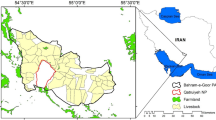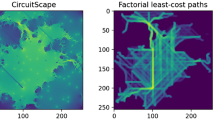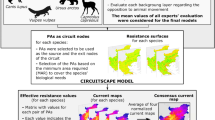Abstract
Context
Graph-theoretic evaluations of habitat connectivity often rely upon least-cost path analyses to evaluate connectedness of habitat patches, based on an underlying cost surface. We present two improvements upon these methods.
Objectives
As a case study to test these methods, we evaluated habitat connectivity for the endangered San Martin titi monkey (Plecturocebus oenanthe) in north-central Peru, to prioritize habitat patches for conservation.
Methods
First, rather than using a single least-cost path between habitat patches, we analyzed multigraphs made up of multiple low-cost paths. This allows us to differentiate between patches connected through a single narrow corridor, and patches connected by a wide swath of traversable land. We evaluate potential movement pathways by iteratively removing paths and recomputing connectivity metrics. Second, instead of performing a sensitivity analysis by varying costs uniformly across the landscape, we generated landscapes with spatially varying costs.
Results
This approach produced a more informative assessment of connectivity than standard graph analyses. Of the 4340 habitat patches considered across the landscape, we identified the most important 100, those frequently ranked highly through repeated network modifications, for multiple metrics and cost surfaces.
Conclusions
These methods represent a novel approach for assessing connectivity, better accounting for spatial configurations of habitat patches and uncertainty in cost surfaces. The ability to identify habitat patches with more possible routes to other patches is of interest for resiliency planning and prioritization in the face of continued habitat loss and climate change. These methods should be broadly applicable to conservation planning for other wildlife species.







Similar content being viewed by others
References
Adriaensen F, Chardon J, De Blust G, Swinnen E, Villalba S, Gulinck H, Matthysen E (2003) The application of ‘least-cost’ modelling as a functional landscape model. Landsc Urban Plann 64:233–247
Allgas N, Shanee S, Shanee N, Chambers J, Tello-Alvarado JC, Keeley K, Pinasco K (2016) Natural re-establishment of a population of a critically endangered primate in a secondary forest: the San Martin titi monkey (Plecturocebus oenanthe) at the Pucunucho Private Conservation Area, Peru. Primates 1–8
Awade M, Boscolo D, Metzger JP (2012) Using binary and probabilistic habitat availability indices derived from graph theory to model bird occurrence in fragmented forests. Landscape Ecol 27:185–198
Baranyi G, Saura S, Podani J, Jordán F (2011) Contribution of habitat patches to network connectivity: redundancy and uniqueness of topological indices. Ecol Indic 11:1301–1310
Beier P, Majka DR, Newell SL (2009) Uncertainty analysis of least-cost modeling for designing wildlife linkages. Ecol Appl 19:2067–2077
Benson AR, Gleich DF, Leskovec J (2016) Higher-order organization of complex networks. Science 353:163–166
Bodin Ö, Norberg J (2007) A network approach for analyzing spatially structured populations in fragmented landscape. Landscape Ecol 22:31–44
Bodin Ö, Saura S (2010) Ranking individual habitat patches as connectivity providers: integrating network analysis and patch removal experiments. Ecol Model 221:2393–2405
Borgatti SP (2005) Centrality and network flow. Soc Netw 27:55–71
Bóveda-Penalba AJ, Vermeer J, Rodrigo F, Guerra-Vásquez F (2009) Preliminary report on the distribution of Callicebus oenanthe on the eastern feet of the Andes. Int J Primatol 30:467–480
Brooks CP (2006) Quantifying population substructure: extending the graph-theoretic approach. Ecology 87:864–872
Brooks TM, Mittermeier RA, da Fonseca GA, Gerlach J, Hoffmann M, Lamoreux JF, Mittermeier CG, Pilgrim JD, Rodrigues AS (2006) Global biodiversity conservation priorities. Science 313:58–61
Bunn AG, Urban DL, Keitt T (2000) Landscape connectivity: a conservation application of graph theory. J Environ Manag 59:265–278
Byrne H, Rylands AB, Carneiro JC, Alfaro JWL, Bertuol F, da Silva MN, Messias M, Groves CP, Mittermeier RA, Farias I (2016) Phylogenetic relationships of the New World titi monkeys (Callicebus): first appraisal of taxonomy based on molecular evidence. Front Zool 13:10
Castillo JA, Epps CW, Davis AR, Cushman SA (2014) Landscape effects on gene flow for a climate-sensitive montane species, the American pika. Mol Ecol 23:843–856
Coulon A, Cosson J, Angibault J, Cargnelutti B, Galan M, Morellet N, Petit E, Aulagnier S, Hewison A (2004) Landscape connectivity influences gene flow in a roe deer population inhabiting a fragmented landscape: an individual–based approach. Mol Ecol 13:2841–2850
Crooks KR, Sanjayan M (2006) Connectivity conservation: maintaining connections for nature. In: Connectivity conservation. Conservation biology, vol 14. Cambridge University Press, New York, pp 1–19
Csardi G, Nepusz T (2006) The igraph software package for complex network research. InterJournal Complex Syst 1695(5):1–9
Cushman SA, Landguth EL (2012) Multi-taxa population connectivity in the Northern Rocky Mountains. Ecol Model 231:101–112
Cushman SA, McKelvey KS, Hayden J, Schwartz MK (2006) Gene flow in complex landscapes: testing multiple hypotheses with causal modeling. Am Nat 168:486–499
Cushman SA, McKelvey KS, Schwartz MK (2009) Use of empirically derived source-destination models to map regional conservation corridors. Conserv Biol 23:368–376
Dale M, Fortin M-J (2010) From graphs to spatial graphs. Annu Rev Ecol Evol Syst 41:21
De Genst W, Canters F, Gulinck H (2001) Uncertainty modeling in buffer operations applied to connectivity analysis. Trans GIS 5:305–326
DeLuycker AM (2006) Preliminary report and conservation status of the Rio Mayo titi monkey, Callicebus oenanthe Thomas, 1924, in the Alto Mayo Valley. Northeastern Peru. Primate Conserv 2006(21):33–40
DeLuycker AM (2007) The ecology and behavior of the Río Mayo titi monkey (Callicebus oenanthe) in the Alto Mayo, northern Peru. ProQuest,
El Presidente de la República (2014) Decreto Supremo que aprueba la actualización de la lista de clasificación y categorización de las especies amenazadas de fauna silvestre legalmente protegidas. Peru
Epps CW, Wehausen JD, Bleich VC, Torres SG, Brashares JS (2007) Optimizing dispersal and corridor models using landscape genetics. J Appl Ecol 44:714–724
Ernest M (2015) Habitat quality and integrative connectivity analysis for Callicebus Oenanthe in San Martin. Duke University, Peru
Estrada E, Bodin Ö (2008) Using network centrality measures to manage landscape connectivity. Ecol Appl 18:1810–1825
Estrada-Peña A (2005) Effects of habitat suitability and landscape patterns on tick (Acarina) metapopulation processes. Landscape Ecol 20:529–541
Etherington TR, Holland EP, O’Sullivan D (2015) NLMpy: a python software package for the creation of neutral landscape models within a general numerical framework. Methods Ecol Evol 6:164–168
Fahrig L (2002) Effect of habitat fragmentation on the extinction threshold: a synthesis. Ecol Appl 12:346–353
Fahrig L (2007) Non-optimal animal movement in human-altered landscapes. Funct Ecol 21:1003–1015
Fall A, Fortin M-J, Manseau M, O’Brien D (2007) Spatial graphs: principles and applications for habitat connectivity. Ecosystems 10:448–461
Forman RT, Godron M (1986) Landscape ecology. Wiley, New York
Galpern P, Manseau M, Fall A (2011) Patch-based graphs of landscape connectivity: a guide to construction, analysis and application for conservation. Biol Conserv 144:44–55
Girvan M, Newman ME (2002) Community structure in social and biological networks. Proc Natl Acad Sci USA 99:7821–7826
Grupo de Trabajo Multisectorial (2008) Diagnóstico Ambiental del Perú. Ministerio del Ambiente, Lima
Instituto de Investigaciones de la Amazonía Peruana (2006) Estrategia Regional de Diversidad Biológica de San Martín. Iquitos, Perú
IUCN (2013) The IUCN Red list of threatened species. http://www.iucnredlist.org. Accessed 1 Dec 2013
Jordán F, Báldi A, Orci K-M, Racz I, Varga Z (2003) Characterizing the importance of habitat patches and corridors in maintaining the landscape connectivity of a Pholidoptera transsylvanica (Orthoptera) metapopulation. Landscape Ecol 18:83–92
Jordán F, Magura T, Tóthmérész B, Vasas V, Ködöböcz V (2007) Carabids (Coleoptera: Carabidae) in a forest patchwork: a connectivity analysis of the Bereg Plain landscape graph. Landscape Ecol 22:1527–1539
Keitt TH (2000) Spectral representation of neutral landscapes. Landscape Ecol 15:479–494
Keitt TH, Urban DL, Milne BT (1997) Detecting critical scales in fragmented landscapes. Conserv Ecol 1:4
Kindlmann P, Burel F (2008) Connectivity measures: a review. Landscape Ecol 23:879–890
Lau W-C, Erramilli A, Wang JL, Willinger W (1995) Self-similar traffic generation: The random midpoint displacement algorithm and its properties. In: 1995 IEEE international conference on communications, 1995. ICC’95 Seattle,’ Gateway to Globalization’. IEEE, pp 466–472
Loro M, Ortega E, Arce RM, Geneletti D (2015) Ecological connectivity analysis to reduce the barrier effect of roads. An innovative graph-theory approach to define wildlife corridors with multiple paths and without bottlenecks. Landsc Urban Plann 139:149–162
McRae BH (2006) Isolation by resistance. Evolution 60:1551–1561
McRae BH, Dickson BG, Keitt TH, Shah VB (2008) Using circuit theory to model connectivity in ecology, evolution, and conservation. Ecology 89:2712–2724
Michels E, Cottenie K, Neys L, De Gelas K, Coppin P, De Meester L (2001) Geographical and genetic distances among zooplankton populations in a set of interconnected ponds: a plea for using GIS modelling of the effective geographical distance. Mol Ecol 10:1929–1938
Minor ES, Urban DL (2007) Graph theory as a proxy for spatially explicit population models in conservation planning. Ecol Appl 17:1771–1782
Minor ES, Urban DL (2008) A graph-theory framework for evaluating landscape connectivity and conservation planning. Conserv Biol 22:297–307
Moilanen A (2011) On the limitations of graph-theoretic connectivity in spatial ecology and conservation. J Appl Ecol 48:1543–1547
Myers N, Mittermeier RA, Mittermeier CG, Da Fonseca GA, Kent J (2000) Biodiversity hotspots for conservation priorities. Nature 403:853–858
Palmer SC, Coulon A, Travis JM (2011) Introducing a ‘stochastic movement simulator’ for estimating habitat connectivity. Methods Ecol Evol 2:258–268
Panzacchi M, Van Moorter B, Strand O, Saerens M, Kivimäki I, St. Clair CC, Herfindal I, Boitani L (2016) Predicting the continuum between corridors and barriers to animal movements using step selection functions and randomized shortest paths. J Anim Ecol 85:32–42
Paquet P, Alexander S, Swan P, Darimont C (2006) Influence of natural landscape fragmentation and resource availability on distribution and connectivity of gray wolves (Canis lupus) in the archipelago of coastal British Columbia, Canada. In: Connectivity Conservation. Conservation Biology, vol 14. Cambridge University Press, New York, pp 130–156
Pascual-Hortal L, Saura S (2006) Comparison and development of new graph-based landscape connectivity indices: towards the priorization of habitat patches and corridors for conservation. Landscape Ecol 21:959–967
Pelletier D, Clark M, Anderson MG, Rayfield B, Wulder MA, Cardille JA (2014) Applying circuit theory for corridor expansion and management at regional scales: tiling, pinch points, and omnidirectional connectivity. PLoS ONE 9(1):e84135
Pinto N, Keitt TH (2009) Beyond the least-cost path: evaluating corridor redundancy using a graph-theoretic approach. Landscape Ecol 24:253–266
R Core Team (2015) R: a language and environment for statistical computing, 3.2.2 edn. R Foundation for Statistical Computing, Vienna
Rae C, Rothley K, Dragicevic S (2007) Implications of error and uncertainty for an environmental planning scenario: a sensitivity analysis of GIS-based variables in a reserve design exercise. Landsc Urban Plann 79:210–217
Rayfield B, Fortin M-J, Fall A (2010) The sensitivity of least-cost habitat graphs to relative cost surface values. Landscape Ecol 25:519–532
Saura S, Estreguil C, Mouton C, Rodríguez-Freire M (2011) Network analysis to assess landscape connectivity trends: application to European forests (1990–2000). Ecol Indic 11:407–416
Sawyer SC, Epps CW, Brashares JS (2011) Placing linkages among fragmented habitats: do least-cost models reflect how animals use landscapes? J Appl Ecol 48:668–678
Schaffer-Smith D, Swenson J, Bóveda-Penalba AJ (2016) Rapid conservation assessment for endangered species using habitat connectivity models. Environ Conserv 43(3):221–230
Schick RS, Lindley ST (2007) Directed connectivity among fish populations in a riverine network. J Appl Ecol 44:1116–1126
Shanee S, Tello-Alvarado JC, Vermeer J, Bóveda-Penalba AJ (2013) GIS risk assessment and GAP analysis for the Andean titi monkey (Callicebus oenanthe). Primate Conserv 26:17–23
Shirk A, Wallin D, Cushman SA, Rice C, Warheit K (2010) Inferring landscape effects on gene flow: a new model selection framework. Mol Ecol 19:3603–3619
Spear SF, Peterson CR, Matocq MD, Storfer A (2005) Landscape genetics of the blotched tiger salamander (Ambystoma tigrinum melanostictum). Mol Ecol 14:2553–2564
Stevens VM, Verkenne C, Vandewoestijne S, Wesselingh RA, Baguette M (2006) Gene flow and functional connectivity in the natterjack toad. Mol Ecol 15:2333–2344
Swenson JJ, Young BE, Beck S, Comer P, Córdova JH, Dyson J, Embert D, Encarnación F, Ferreira W, Franke I, Grossman D, Hernandez P, Herzog SK, Josse C, Navarro G, Pacheco V, Stein BA, Timaná M, Tovar A, Tovar C, Vargas J, Zambrana-Torrelio CM (2012) Plant and animal endemism in the eastern Andean slope: challenges to conservation. BMC Ecol 12:1
Theobald DM (2006) Exploring the functional connectivity of landscapes using landscape networks. In: Connectivity conservation. Conservation biology, vol 14. Cambridge University Press, New York, pp 416–443
Torné J, Saura S (2013) Conefor, 2.7.1—Command line version 1.0.21 edn
Urban DL, Keitt T (2001) Landscape connectivity: a graph-theoretic perspective. Ecology 82:1205–1218
Urban DL, Minor ES, Treml EA, Schick RS (2009) Graph models of habitat mosaics. Ecol Lett 12:260–273
van Strien MJ, García-Suikkanen C, Tello-Alvarado JC, Vermeer J, Hill CM (2016) Estimating population density of the San Martin Titi monkey (Callicebus oenanthe) in Peru using vocalisations. Folia Primatol 86:525–533
Vermeer J (2015) San Martín Titi Monkey, Callicebus oenanthe Thomas, 1924, Peru, (2012, 2014). In: Schwitzer C, Mittermeier RA, Rylands AB, Chiozza F, Williamson EA, Wallis J, Cotton A (eds) Primates in Peril: The World’s Most Endangered Primates 2014–2016. Arlington, VA., pp 81–82
Zador M, Young BE, Josse C, Stern M, Vasconez S, Olander J, Sanchez de Lozada A, Smyth R, Comer PJ, Moull K, Echavarría M, Hak J (2015) Ecoystem profile: tropical andes biodiversity hotspot. Critical Ecosystem Partnership Fund; NatureServe and EcoDecisión
Zeller KA, Jennings MK, Vickers TW, Ernest HB, Cushman SA, Boyce WM (2018) Are all data types and connectivity models created equal? Validating common connectivity approaches with dispersal data. Divers Distrib 24(7):868–879
Zeller KA, McGarigal K, Whiteley AR (2012) Estimating landscape resistance to movement: a review. Landscape Ecol 27:777–797
Zetterberg A, Mörtberg UM, Balfors B (2010) Making graph theory operational for landscape ecological assessments, planning, and design. Landsc Urban Plann 95:181–191
Ziółkowska E, Ostapowicz K, Radeloff VC, Kuemmerle T (2014) Effects of different matrix representations and connectivity measures on habitat network assessments. Landscape Ecol 29:1551–1570
Acknowledgements
This project would not have been possible without the generous help and support of a large number of people. In particular, we would like to thank Dr. Anneke DeLuycker, Rosario Huashuayo Llamocca, Dr. Carolina García-Suikkanen, Silvy Van Kuijk, and Jan Vermeer for providing movement cost estimates for the titi monkey. The staff of Proyecto Mono Tocón showed us incredible hospitality during our time in Peru, and assisted in the fieldwork to map land cover, which was used as the basis of this analysis. Maggie Ernest and John Fay provided valuable advice in the early stages of this work. We also thank the Nicholas School International Internship and Environmental Internship Funds, and the Center for Latin American and Caribbean Studies at Duke University, for their generous financial support.
Author information
Authors and Affiliations
Corresponding author
Additional information
Publisher's Note
Springer Nature remains neutral with regard to jurisdictional claims in published maps and institutional affiliations.
Electronic supplementary material
Below is the link to the electronic supplementary material.
Rights and permissions
About this article
Cite this article
Walker, N.J., Schaffer-Smith, D., Swenson, J.J. et al. Improved connectivity analysis using multiple low-cost paths to evaluate habitat for the endangered San Martin titi monkey (Plecturocebus oenanthe) in north-central Peru. Landscape Ecol 34, 1859–1875 (2019). https://doi.org/10.1007/s10980-019-00837-4
Received:
Accepted:
Published:
Issue Date:
DOI: https://doi.org/10.1007/s10980-019-00837-4




